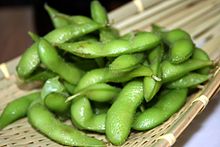Edamame
This article needs additional citations for verification. (December 2011) |
| Edamame | |
|---|---|

| |
| Boiled green fruit soybeans in the pod. | |
| Scientific classification | |
| Kingdom: | |
| (unranked): | |
| (unranked): | |
| (unranked): | |
| Order: | |
| Family: | |
| Subfamily: | |
| Genus: | |
| Species: | G. max
|
| Binomial name | |
| Glycine max | |

Edamame (枝豆) (/ˌɛdəˈmɑːmeɪ/) or edamame bean is a preparation of immature soybeans in the pod, found in the cuisine of Japan, China and Hawaii. The pods are boiled or steamed and served with salt.
Outside East Asia, the dish is most often found in Japanese restaurants and some Chinese restaurants but it also has found popularity elsewhere as a healthy food item. In the United States it is often sold in bags in the frozen food section of grocery stores.[citation needed]
Name
The Japanese name, edamame (枝豆), is used commonly to refer to the dish.A It literally means, "twig bean" (eda = "twig" + mame = "bean"). Edamame is a popular side dish at Japanese izakaya restaurants with local varieties being in demand, depending on the season.[citation needed] Salt is a typical condiment for edamame. In Japan, arajio is the preferred salt, because it is a natural sea salt.[citation needed] This coarse salt is wet with brine, thus loaded with marine and mineral flavors.[citation needed]
History
The earliest documented reference to the term "edamame" dates from the year 1275, when the well-known Japanese monk, Nichiren, wrote a note thanking a parishioner for the gift of "edamame" he had left at the temple.[1] Edamame appeared in haikai verse in Japanese in the Edo period (1603 – 1868), with one example as early as 1638.[2] The earliest recorded usage in English of the word edamame is in 1951 in the journal Folklore Studies.[3] Edamame appeared as a new term in the Oxford English Dictionary in 2003, and in the Merriam-Webster dictionary in 2008.[4]
Preparation
Green soybeans in the pod are picked before they ripen in order to prepare edamame. The ends of the pod may be cut before boiling or steaming.
Then the pods are boiled in water, steamed or microwaved. The most common preparation uses salt for taste. The salt may either be dissolved in the boiling water before introducing the soybean pods, or it may be added after the pods have been cooked.
Nutrient content
| Nutritional value per 100 g (3.5 oz) | |
|---|---|
| Energy | 509 kJ (122 kcal) |
9.94 g | |
| Sugars | 2.18 g |
| Dietary fiber | 5.2 g |
5.2 g | |
10.88 g | |
| Vitamins | Quantity %DV† |
| Thiamine (B1) | 17% 0.2 mg |
| Riboflavin (B2) | 12% 0.155 mg |
| Niacin (B3) | 6% 0.915 mg |
| Pantothenic acid (B5) | 8% 0.395 mg |
| Vitamin B6 | 6% 0.1 mg |
| Folate (B9) | 78% 311 μg |
| Vitamin C | 7% 6.1 mg |
| Vitamin E | 5% 0.68 mg |
| Vitamin K | 22% 26.8 μg |
| Minerals | Quantity %DV† |
| Calcium | 5% 63 mg |
| Iron | 13% 2.27 mg |
| Magnesium | 15% 64 mg |
| Manganese | 45% 1.024 mg |
| Phosphorus | 14% 169 mg |
| Potassium | 15% 436 mg |
| Zinc | 12% 1.37 mg |
| †Percentages estimated using US recommendations for adults,[5] except for potassium, which is estimated based on expert recommendation from the National Academies.[6] | |
The United States Department of Agriculture states that edamame beans are "a soybean that can be eaten fresh and are best known as a snack with a nutritional punch".[7]
Edamame and all preparations of soybeans are rich in carbohydrates, protein, dietary fiber, and micronutrients, particularly folates, manganese, and vitamin K (table).[8]
The balance of fatty acids in 100 grams of edamame is 361 mg of omega-3 fatty acids to 1794 mg of omega-6 fatty acids.[9]
Edamame beans contain higher levels of abscisic acid, sucrose, and protein than other types of soybeans,[citation needed] and may contain carotenoids.[10]
Footnotes
- A.^ The Nihon Kokugo Daijiten records two regional name variants for the word edamame: rakkasei (落花生)in Tottori Prefecture, and daizu (大豆), the generic word for soybeans, in Wakayama Prefecture.[2]
References
- ^ History of Edamame, Green Vegetable Soybeans, and Vegetable-Type Soybeans (1275-2009)
- ^ a b "枝豆". Nihon Kokugo Daijiten (in Japanese). Tokyo: Shogakukan. 2012. OCLC 56431036. Retrieved 2012-06-06.
{{cite encyclopedia}}: Unknown parameter|trans_title=ignored (|trans-title=suggested) (help) - ^ "Edamame, n.". Oxford English dictionary (3rd ed.). Oxford, England: Oxford University Press. 2012. LCCN 2002565560. OCLC 357047940. Retrieved June 6, 2012.
{{cite encyclopedia}}: Unknown parameter|month=ignored (help) - ^ "Edamame". Jōhō chishiki imidas (in Japanese). Tōkyō: Shūeisha. 2012. OCLC 297351993. Retrieved June 6, 2012.
- ^ United States Food and Drug Administration (2024). "Daily Value on the Nutrition and Supplement Facts Labels". FDA. Archived from the original on 2024-03-27. Retrieved 2024-03-28.
- ^ National Academies of Sciences, Engineering, and Medicine; Health and Medicine Division; Food and Nutrition Board; Committee to Review the Dietary Reference Intakes for Sodium and Potassium (2019). Oria, Maria; Harrison, Meghan; Stallings, Virginia A. (eds.). Dietary Reference Intakes for Sodium and Potassium. The National Academies Collection: Reports funded by National Institutes of Health. Washington, DC: National Academies Press (US). ISBN 978-0-309-48834-1. PMID 30844154. Archived from the original on 2024-05-09. Retrieved 2024-06-21.
- ^ USDA government article about edamame.
- ^ "Edamame nutrition profile (frozen, unprepared)". NutritionData. Retrieved 2010-04-08.
- ^ "Edamame nutrition profile (frozen, prepared)". NutritionData. Retrieved 2012-03-24.
- ^ Simonne, A. H.; Smith, M.; Weaver, D. B.; Vail, T.; Barnes, S.; Wei, C. I. (2000). "Retention and Changes of Soy Isoflavones and Carotenoids in Immature Soybean Seeds (Edamame) during Processing". Journal of Agricultural and Food Chemistry. 48 (12): 6061–9. doi:10.1021/jf000247f. PMID 11141271.

